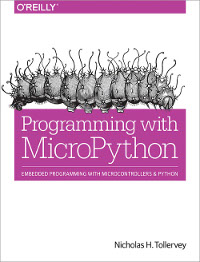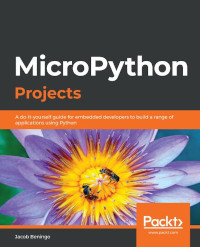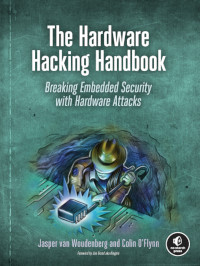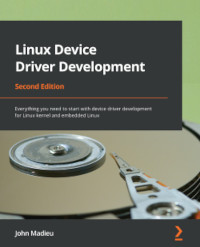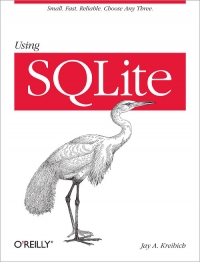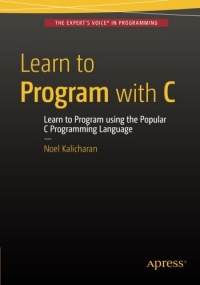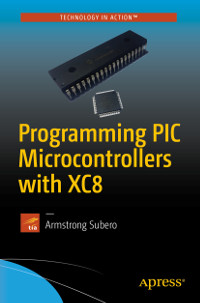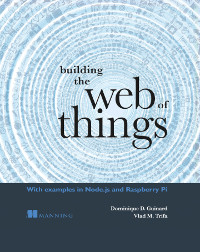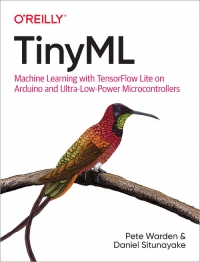Programming with MicroPython
It's an exciting time to get involved with MicroPython, the re-implementation of Python 3 for microcontrollers and embedded systems. This practical guide delivers the knowledge you need to roll up your sleeves and create exceptional embedded projects with this lean and efficient programming language. If you're familiar with Python as a programmer, educator, or maker, you're ready to learn—and have fun along the way. Author Nicholas Tollervey takes you on a journey from first steps to advanced projects. You'll explore the types of devices that run MicroPython, and examine how the language uses and interacts with hardware to process input, connect to the outside world, communicate wirelessly, make sounds and music, and drive robotics projects. Work with MicroPython on four typical devices: PyBoard, the micro:bit, Adafruit's Circuit Playground Express, and ESP8266/ESP32 boards; Explore a framework that helps you generate, evaluate, and evolve embedded projects that solve real prob ...
It's an exciting time to get involved with MicroPython, the re-implementation of Python 3 for microcontrollers and embedded systems. This practical guide delivers the knowledge you need to roll up your sleeves and create exceptional embedded projects with this lean and efficient programming language. If you're familiar with Python as a programmer, educator, or maker, you're ready to learn—and have fun along the way. Author Nicholas Tollervey takes you on a journey from first steps to advanced projects. You'll explore the types of devices that run MicroPython, and examine how the language uses and interacts with hardware to process input, connect to the outside world, communicate wirelessly, make sounds and music, and drive robotics projects. Work with MicroPython on four typical devices: PyBoard, the micro:bit, Adafruit's Circuit Playground Express, and ESP8266/ESP32 boards; Explore a framework that helps you generate, evaluate, and evolve embedded projects that solve real prob ...
MicroPython Projects
With the increasing complexity of embedded systems seen over the past few years, developers are looking for ways to manage them easily by solving problems without spending a lot of time on finding supported peripherals. MicroPython is an efficient and lean implementation of the Python 3 programming language, which is optimized to run on microcontrollers. MicroPython Projects will guide you in building and managing your embedded systems with ease. This book is a comprehensive project-based guide that will help you build a wide range of projects and give you the confidence to design complex projects spanning new areas of technology such as electronic applications, automation devices, and IoT applications. While building seven engaging projects, you'll learn how to enable devices to communicate with each other, access and control devices over a TCP/IP socket, and store and retrieve data. The complexity will increase progressively as you work on different projects, covering areas such a ...
With the increasing complexity of embedded systems seen over the past few years, developers are looking for ways to manage them easily by solving problems without spending a lot of time on finding supported peripherals. MicroPython is an efficient and lean implementation of the Python 3 programming language, which is optimized to run on microcontrollers. MicroPython Projects will guide you in building and managing your embedded systems with ease. This book is a comprehensive project-based guide that will help you build a wide range of projects and give you the confidence to design complex projects spanning new areas of technology such as electronic applications, automation devices, and IoT applications. While building seven engaging projects, you'll learn how to enable devices to communicate with each other, access and control devices over a TCP/IP socket, and store and retrieve data. The complexity will increase progressively as you work on different projects, covering areas such a ...
Patterns in the Machine
Discover how to apply software engineering patterns to develop more robust firmware faster than traditional embedded development approaches. In the authors' experience, traditional embedded software projects tend towards monolithic applications that are optimized for their target hardware platforms. This leads to software that is fragile in terms of extensibility and difficult to test without fully integrated software and hardware. Patterns in the Machine focuses on creating loosely coupled implementations that embrace both change and testability. This book illustrates how implementing continuous integration, automated unit testing, platform-independent code, and other best practices that are not typically implemented in the embedded systems world is not just feasible but also practical for today's embedded projects. After reading this book, you will have a better idea of how to structure your embedded software projects. You will recognize that while writing unit tests, creating ...
Discover how to apply software engineering patterns to develop more robust firmware faster than traditional embedded development approaches. In the authors' experience, traditional embedded software projects tend towards monolithic applications that are optimized for their target hardware platforms. This leads to software that is fragile in terms of extensibility and difficult to test without fully integrated software and hardware. Patterns in the Machine focuses on creating loosely coupled implementations that embrace both change and testability. This book illustrates how implementing continuous integration, automated unit testing, platform-independent code, and other best practices that are not typically implemented in the embedded systems world is not just feasible but also practical for today's embedded projects. After reading this book, you will have a better idea of how to structure your embedded software projects. You will recognize that while writing unit tests, creating ...
The Hardware Hacking Handbook
Embedded devices are chip-size microcomputers small enough to be included in the structure of the object they control, and they're everywhere - in phones, cars, credit cards, laptops, medical equipment, even critical infrastructure. This means understanding their security is critical. The Hardware Hacking Handbook takes you deep inside different types of embedded systems, revealing the designs, components, security limits, and reverse-engineering challenges you need to know for executing effective hardware attacks. Written with wit and infused with hands-on lab experiments, this handbook puts you in the role of an attacker interested in breaking security to do good. Starting with a crash course on the architecture of embedded devices, threat modeling, and attack trees, you'll go on to explore hardware interfaces, ports and communication protocols, electrical signaling, tips for analyzing firmware images, and more. Along the way, you'll use a home testing lab to perform fault-injecti ...
Embedded devices are chip-size microcomputers small enough to be included in the structure of the object they control, and they're everywhere - in phones, cars, credit cards, laptops, medical equipment, even critical infrastructure. This means understanding their security is critical. The Hardware Hacking Handbook takes you deep inside different types of embedded systems, revealing the designs, components, security limits, and reverse-engineering challenges you need to know for executing effective hardware attacks. Written with wit and infused with hands-on lab experiments, this handbook puts you in the role of an attacker interested in breaking security to do good. Starting with a crash course on the architecture of embedded devices, threat modeling, and attack trees, you'll go on to explore hardware interfaces, ports and communication protocols, electrical signaling, tips for analyzing firmware images, and more. Along the way, you'll use a home testing lab to perform fault-injecti ...
Linux Device Driver Development, 2nd Edition
Linux is by far the most-used kernel on embedded systems. Thanks to its subsystems, the Linux kernel supports almost all of the application fields in the industrial world. This updated second edition of Linux Device Driver Development is a comprehensive introduction to the Linux kernel world and the different subsystems that it is made of, and will be useful for embedded developers from any discipline. You'll learn how to configure, tailor, and build the Linux kernel. Filled with real-world examples, the book covers each of the most-used subsystems in the embedded domains such as GPIO, direct memory access, interrupt management, and I2C/SPI device drivers. This book will show you how Linux abstracts each device from a hardware point of view and how a device is bound to its driver(s). You'll also see how interrupts are propagated in the system as the book covers the interrupt processing mechanisms in-depth and describes every kernel structure and API involved. This new edition also a ...
Linux is by far the most-used kernel on embedded systems. Thanks to its subsystems, the Linux kernel supports almost all of the application fields in the industrial world. This updated second edition of Linux Device Driver Development is a comprehensive introduction to the Linux kernel world and the different subsystems that it is made of, and will be useful for embedded developers from any discipline. You'll learn how to configure, tailor, and build the Linux kernel. Filled with real-world examples, the book covers each of the most-used subsystems in the embedded domains such as GPIO, direct memory access, interrupt management, and I2C/SPI device drivers. This book will show you how Linux abstracts each device from a hardware point of view and how a device is bound to its driver(s). You'll also see how interrupts are propagated in the system as the book covers the interrupt processing mechanisms in-depth and describes every kernel structure and API involved. This new edition also a ...
Using SQLite
You can build database-backed applications for the desktop, Web, embedded systems, or operating systems without linking to heavy-duty client-server databases such as Oracle and MySQL. This book shows you how to use SQLite, a small and lightweight relational database engine that you can build directly into your application. With SQLite, you'll discover how to develop a database-backed application that remains manageable in size and complexity. Using SQLite guides you every step of the way. ...
You can build database-backed applications for the desktop, Web, embedded systems, or operating systems without linking to heavy-duty client-server databases such as Oracle and MySQL. This book shows you how to use SQLite, a small and lightweight relational database engine that you can build directly into your application. With SQLite, you'll discover how to develop a database-backed application that remains manageable in size and complexity. Using SQLite guides you every step of the way. ...
Learn to Program with C
Learn the fundamental programming principles using C, one of the most widely used programming languages in the world today. Learn to Program with C teaches computer programming to the complete beginner using the native C language. As such, it assumes you have no knowledge whatsoever about programming. We discuss only those features and statements in C that are necessary to achieve our goal. Once you learn the principles well, they can be applied to any language. If you are worried that you are not good at high-school mathematics, don't be. It is a myth that you must be good at mathematics to learn programming. C is considered a ‘modern' language even though its roots date back to the 1970s. Originally, C was designed for writing ‘systems' programs—things like operating systems, editors, compilers, assemblers and input/output utility programs. But, today, C is used for writing all kinds of applications as well—word processing programs, spreadsheet programs, database manage ...
Learn the fundamental programming principles using C, one of the most widely used programming languages in the world today. Learn to Program with C teaches computer programming to the complete beginner using the native C language. As such, it assumes you have no knowledge whatsoever about programming. We discuss only those features and statements in C that are necessary to achieve our goal. Once you learn the principles well, they can be applied to any language. If you are worried that you are not good at high-school mathematics, don't be. It is a myth that you must be good at mathematics to learn programming. C is considered a ‘modern' language even though its roots date back to the 1970s. Originally, C was designed for writing ‘systems' programs—things like operating systems, editors, compilers, assemblers and input/output utility programs. But, today, C is used for writing all kinds of applications as well—word processing programs, spreadsheet programs, database manage ...
Programming PIC Microcontrollers with XC8
Learn how to use microcontrollers without all the frills and math. This book uses a practical approach to show you how to develop embedded systems with 8 bit PIC microcontrollers using the XC8 compiler. It's your complete guide to understanding modern PIC microcontrollers. Are you tired of copying and pasting code into your embedded projects? Do you want to write your own code from scratch for microcontrollers and understand what your code is doing? Do you want to move beyond the Arduino? Then Programming PIC Microcontrollers with XC8 is for you! Written for those who want more than an Arduino, but less than the more complex microcontrollers on the market, PIC microcontrollers are the next logical step in your journey. You'll also see the advantage that MPLAB X offers by running on Windows, MAC and Linux environments. You don't need to be a command line expert to work with PIC microcontrollers, so you can focus less on setting up your environment and more on your application. ...
Learn how to use microcontrollers without all the frills and math. This book uses a practical approach to show you how to develop embedded systems with 8 bit PIC microcontrollers using the XC8 compiler. It's your complete guide to understanding modern PIC microcontrollers. Are you tired of copying and pasting code into your embedded projects? Do you want to write your own code from scratch for microcontrollers and understand what your code is doing? Do you want to move beyond the Arduino? Then Programming PIC Microcontrollers with XC8 is for you! Written for those who want more than an Arduino, but less than the more complex microcontrollers on the market, PIC microcontrollers are the next logical step in your journey. You'll also see the advantage that MPLAB X offers by running on Windows, MAC and Linux environments. You don't need to be a command line expert to work with PIC microcontrollers, so you can focus less on setting up your environment and more on your application. ...
Building the Web of Things
A hands-on guide that teaches you how to design and implement scalable, flexible, and open IoT solutions using web technologies. This book focuses on providing the right balance of theory, code samples, and practical examples to enable you to successfully connect all sorts of devices to the web and to expose their services and data over REST APIs. Because the Internet of Things is still new, there is no universal application protocol. Fortunately, the IoT can take advantage of the web, where IoT protocols connect applications thanks to universal and open APIs. Building the Web of Things is a guide to using cutting-edge web technologies to build the IoT. This step-by-step book teaches you how to use web protocols to connect real-world devices to the web, including the Semantic and Social Webs. Along the way you?ll gain vital concepts as you follow instructions for making Web of Things devices. By the end, you'll have the practical skills you need to implement your own web-connecte ...
A hands-on guide that teaches you how to design and implement scalable, flexible, and open IoT solutions using web technologies. This book focuses on providing the right balance of theory, code samples, and practical examples to enable you to successfully connect all sorts of devices to the web and to expose their services and data over REST APIs. Because the Internet of Things is still new, there is no universal application protocol. Fortunately, the IoT can take advantage of the web, where IoT protocols connect applications thanks to universal and open APIs. Building the Web of Things is a guide to using cutting-edge web technologies to build the IoT. This step-by-step book teaches you how to use web protocols to connect real-world devices to the web, including the Semantic and Social Webs. Along the way you?ll gain vital concepts as you follow instructions for making Web of Things devices. By the end, you'll have the practical skills you need to implement your own web-connecte ...
TinyML
Deep learning networks are getting smaller. Much smaller. The Google Assistant team can detect words with a model just 14 kilobytes in size - small enough to run on a microcontroller. With this practical book you'll enter the field of TinyML, where deep learning and embedded systems combine to make astounding things possible with tiny devices. Pete Warden and Daniel Situnayake explain how you can train models small enough to fit into any environment. Ideal for software and hardware developers who want to build embedded systems using machine learning, this guide walks you through creating a series of TinyML projects, step-by-step. No machine learning or microcontroller experience is necessary. Build a speech recognizer, a camera that detects people, and a magic wand that responds to gestures; Work with Arduino and ultra-low-power microcontrollers; Learn the essentials of ML and how to train your own models; Train models to understand audio, image, and accelerometer data; Explore T ...
Deep learning networks are getting smaller. Much smaller. The Google Assistant team can detect words with a model just 14 kilobytes in size - small enough to run on a microcontroller. With this practical book you'll enter the field of TinyML, where deep learning and embedded systems combine to make astounding things possible with tiny devices. Pete Warden and Daniel Situnayake explain how you can train models small enough to fit into any environment. Ideal for software and hardware developers who want to build embedded systems using machine learning, this guide walks you through creating a series of TinyML projects, step-by-step. No machine learning or microcontroller experience is necessary. Build a speech recognizer, a camera that detects people, and a magic wand that responds to gestures; Work with Arduino and ultra-low-power microcontrollers; Learn the essentials of ML and how to train your own models; Train models to understand audio, image, and accelerometer data; Explore T ...
